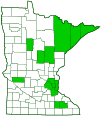obscure plant bug
(Plagiognathus obscurus)
Conservation • Description • Habitat • Ecology • Distribution • Taxonomy
|
|
||||||||||||||
Description |
Obscure plant bug is a common, small, plant bug. It occurs in the United States in the east from Maine to Virginia, west to Montana and New Mexico. In the west it occurs from Washington to northern Utah, and south to northern California. It also occurs across southern Canada from Nova Scotia to British Columbia. Host preferences for Plagiognathus species are not well documented. Many feed on a single woody plant species, but some feed on a variety of annual plants. Although Plagiognathus obscurus is the most commonly collected species in the genus Plagiognathus, it has been recorded feeding on a relatively small number of plant species. In Minnesota, those species include American cow parsnip, asters, beaked hazelnut, birches, blue beech, bur oak, elms, green ash, hickories, meadowsweets, nettles, peas, roses, smooth sumac, snowberries, sweet clovers, and willows. In other areas, it also includes bristle thistle, ponderosa pine, water birch, and western azalea. It apparently breeds on annuals. Males are ⅛″ to 3⁄16″ (3.23 to 4.56 mm) in length. That is small for a plant bug (family Miridae) but relatively large for one in the genus Plagiognathus. The body is soft, elongate, and more or less parallel-sided when viewed from above, flattened when viewed from the side. It is dark brown to black (dark) and whitish yellow or yellowish white (pale), and it is moderately covered with reclining, shiny, golden hairs. The head is short, wider than long, and dark. The mouth parts are optimized for piercing and sucking. They take the form of a long, 4-segmented beak. The first segment is dark, and the remaining segments are pale. When not used, the beak extends from the front of the head, along the underside of the body between the legs, to the tip of the first segment (coxa) of the hind legs. The antennae are slender and relatively long, and they have four segments. The first segment is dark except for a pale ring at the end. The second segment is entirely dark. The third and fourth segments usually appear pale or weakly darkened. The plate on the first segment of the thorax (pronotum) is entirely dark. There are two pairs of wings, and they are held flat over the body when at rest. Between and at the wing bases there is a triangular plate (scutellum). The scutellum is entirely dark. The front wings (hemelytra) have a thickened section at the base and a thin membranous section at the tip with a clear dividing line between the two. The thickened basal part is comprised of a narrow area (clavus) behind the scutellum when the wings are closed, and the remaining broad marginal area (corium). At the end of the corium there is a small but distinct triangular area (cuneus). The elytra are mostly dark. The clavus is entirely dark. The corium is mostly dark but usually pale on the basal one-third to one-half. Occasionally it is almost entirely dark. It always has a short, narrow, pale stripe on the inner margin at its widest point, which is near the tip of the membrane. The rear margin of the pale area is angled, and it usually extends toward the tip of the clavus in males. The cuneus is pale at least on the basal third, and sometimes it is entirely pale. The membrane is dark. The veins are usually weakly to moderately contrasting with the dark membrane. The hind wings are thin and membranous. The underside of the body is entirely dark. The legs are usually mostly pale with dark spots. The third segment (femur) is sometimes darkened. The fourth segment (tibia) is pale, dark just at the base. It has two rows of spines, and there is a dark spot at the base of each spine. Females are ⅛″ to 3⁄16″ (3.52 to 4.24 mm) in length. The body is broader, more egg-shaped. |
Size |
Female total length: ⅛″ to 3⁄16″ (3.52 to 4.24 mm) Male total length: ⅛″ to 3⁄16″ (3.23 to 4.56 mm) |
Similar Species |
Habitat |
|
Ecology |
Season |
Late May to September |
Behavior |
|
Life Cycle |
|
Nymph Food |
|
Adult Food |
American cow parsnip, asters, beaked hazelnut, birches, blue beech, bur oak, elms, green ash, hickories, meadowsweets, nettles, peas, roses, smooth sumac, snowberries, sweet clovers, and willows. In other areas, it also includes bristle thistle, ponderosa pine, water birch, and western azalea. |
Distribution |
||
|
Sources Schuh, Randall T. (n.d.). Revision of New World Plagiognathus Fieber : with comments on the Palearctic fauna and the description of a new genus (Heteroptera, Miridae, Phylinae). Bulletin of the AMNH ; no. 266. https://www.biodiversitylibrary.org/bibliography/88730 |
|
| 1/25/2025 | ||
Occurrence |
||
Common |
||
Taxonomy |
|
Order |
Hemiptera (True bugs, Hoppers, Aphids, and Allies) |
Suborder |
Heteroptera (True Bugs) |
Infraorder |
Cimicomorpha |
Superfamily |
Miroidea |
Family |
|
Subfamily |
Phylinae |
Tribe |
Phylini |
Subtribe |
Oncotylina |
Genus |
Plagiognathus |
Subordinate Taxa |
|
|
|
Synonyms |
|
Plagiognathus albocuneatus Plagiognathus annulatus ssp. cuneatus Plagiognathus annulatus ssp. nigrofemoratus Plagiognathus cuneatus Plagiognathus nigrofemoratus Plagiognathus obscurus ssp. albocuneatus Plagiognathus obscurus ssp. obscurus |
|
Common Names |
|
obscure plant bug |
|
Glossary
Beak
In plants: A comparatively short and stout, narrow or prolonged tip on a thickened organ, as on some fruits and seeds. In insects: The protruding, tubular mouthpart of a sucking insect.
Clavus
On Hemiptera: The hard part of the forewing that is adjacent to the scutellum when the wings are closed. Plural: clavi.
Corium
The thickened basal portion of the front wing that lies between the clavus and the membrane of insects in the family Hemiptera. Plural: coria.
Coxa
The first (most proximal) segment of the legs of most arthropods, including all insects, spiders, and crustaceans, and most arachnids. It attaches the leg to the body and connects to the trochanter. Plural: coxae.
Cuneus
The triangular, hardened, horn-like tip of the forewing of a plant bug (family Miridae).
Femur
On insects and arachnids, the third, largest, most robust segment of the leg, coming immediately before the tibia. On humans, the thigh bone.
Hemelytron
The forewing of true bugs (order Hemiptera), thickened at the base and membranous at the tip. Plural: hemelytra.
Pronotum
The exoskeletal plate on the upper side of the first segment of the thorax of an insect.
Scutellum
The exoskeletal plate covering the rearward (posterior) part of the middle segment of the thorax in some insects. In Coleoptera, Hemiptera, and Homoptera, the dorsal, often triangular plate behind the pronotum and between the bases of the front wings. In Diptera, the exoskeletal plate between the abdomen and the thorax.
Tibia
The fourth segment of an insect leg, after the femur and before the tarsus (foot). The fifth segment of a spider leg or palp. Plural: tibiae.
Visitor Photos |
||
Share your photo of this insect. |
||
This button not working for you? |
||
Alfredo Colon |
||
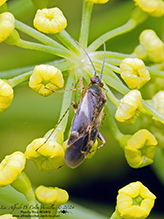 |
||
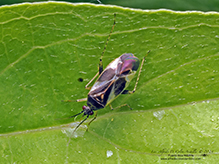 |
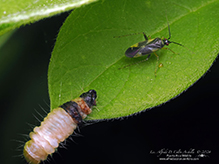 |
|
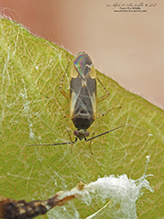 |
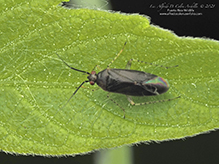 |
|
MinnesotaSeasons.com Photos |
||
|
||
|
||

Slideshows |
|

Visitor Videos |
||
Share your video of this insect. |
||
This button not working for you? |
||
|
Other Videos |
||
|

Visitor Sightings |
||
Report a sighting of this insect. |
||
This button not working for you? |
||
Alfredo Colon |
Location: Albany, NY |
 |
Alfredo Colon |
Location: Albany, NY |
 |
Alfredo Colon |
Location: Albany, NY |
 |
Alfredo Colon |
Location: Woodbury, MN |
 |
MinnesotaSeasons.com Sightings |
||
|

|
Created: 1/25/2025 Last Updated: © MinnesotaSeasons.com. All rights reserved. |
